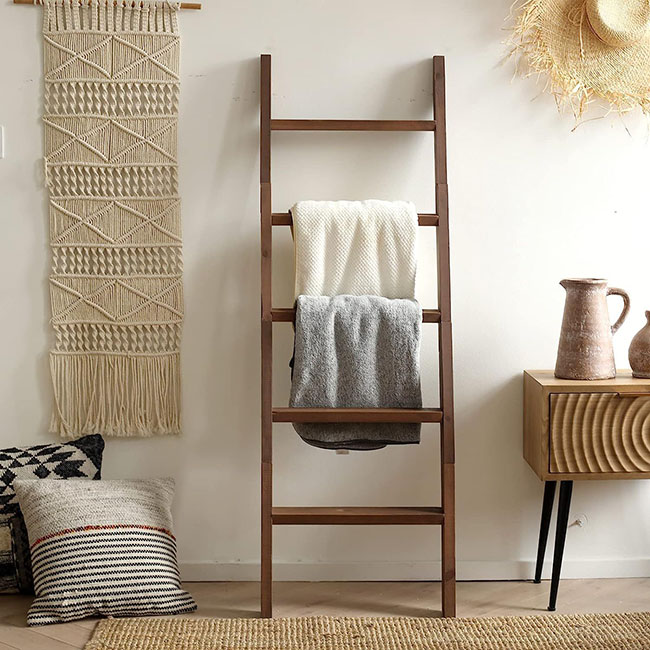The Ultimate Guide to Blanket Ladders: Everything You Need to Know
2024-11-07
Blanket ladders have surged in popularity over recent years, establishing themselves as essential elements in modern home décor. This unassuming piece of furniture seamlessly blends functionality with aesthetic appeal, serving as a stylish way to store and display blankets, quilts, and even towels. If you've ever admired a cozy room accented by a blanket ladder or are considering one for your own space, this comprehensive guide will walk you through everything you need to know—from types and materials to styling tips and DIY solutions. Whether you’re a minimalist or a lover of rustic charm, blanket ladders offer a versatile and budget-friendly solution to elevate your home.
What is a Blanket Ladder?
At its simplest, a blanket ladder is a decorative ladder that leans against a wall, designed to hold and display folded blankets or throws. Originating from practical ladders used for functional purposes like drying towels, the modern blanket ladder has evolved into a decorative statement that adds warmth and texture to living spaces. Typically, blanket ladders are made from wood or metal, and they come in various sizes, colors, and designs to match different interior styles.
Why Use a Blanket Ladder?
The appeal of a blanket ladder goes beyond its ability to organize blankets. Here are some reasons why this piece has become a favorite in home design:
1. Space-Saving: In homes where space is limited, blanket ladders offer an effective solution for storage without occupying much floor space. Unlike bulky cabinets or shelves, a ladder leans compactly against a wall and maximizes vertical space.
2. Aesthetic Appeal: Blanket ladders are inherently charming. They can be rustic, modern, vintage, or industrial, adding character and warmth to a room. By displaying your blankets or throws, you can incorporate color and texture into your décor scheme.
3. Versatility: While their primary use is for displaying blankets, these ladders can also be repurposed for various uses. For example, they can serve as towel holders in a bathroom, accessory hangers in a bedroom, or even a photo display in a living room.
4. Ease of Use: Unlike shelves that might require extensive installation or cabinets that need assembly, blanket ladders are typically ready-to-use upon purchase. Just lean them against a wall and start decorating.
Types of Blanket Ladders
There is a broad spectrum of blanket ladders available to suit different styles and needs. Here, we explore the main types:
1. Wooden Blanket Ladders
These are the most common and versatile type of blanket ladders. Wooden ladders come in a variety of finishes—from natural oak and rustic pine to painted white or black. They fit seamlessly into farmhouse, coastal, Scandinavian, and even contemporary décor themes. The texture of wood provides warmth, making it perfect for cozy living rooms or bedrooms.
2. Metal Blanket Ladders
Metal ladders have a sleek, modern look that works well in industrial, minimalistic, or urban spaces. They often come in black, brass, or chrome finishes and provide a striking contrast when paired with soft, colorful blankets.
3. Mixed Material Ladders
For those looking for something unique, ladders made from a combination of wood and metal offer a blend of styles. These ladders can feature wooden rungs with a metal frame, or vice versa, making them ideal for eclectic interiors that bridge the gap between modern and traditional.
4. DIY Blanket Ladders
Crafty homeowners may prefer to make their own blanket ladders. This option provides customization to match the exact dimensions and finishes you desire. DIY projects are usually more cost-effective and allow for personalization that can’t always be found in store-bought options.
Choosing the Right Blanket Ladder for Your Space
Selecting the ideal blanket ladder involves considering several factors:
1. Size and Height: Ensure the ladder isn’t too tall or short for the space where you intend to place it. For most living rooms or bedrooms, a ladder between 4 and 6 feet in height works well.
2. Material and Finish: The material should align with your room’s existing décor. A wooden ladder may complement a room with lots of natural textures, while a metal ladder can stand out in a minimalist space.
3. Number of Rungs: More rungs mean more storage. If you plan to use the ladder for displaying a collection of blankets or towels, opt for a model with at least four or five rungs.
4. Stability and Safety: Make sure the ladder you choose is stable, with rungs that can support the weight of heavy blankets. Some ladders come with non-slip feet or hardware to secure them to the wall for added safety.
Styling Your Blanket Ladder
Styling a blanket ladder is where your creativity can shine. Here are some ideas to help you showcase your ladder in the most appealing way:
1. Layering Blankets: Display multiple blankets on different rungs for a layered effect. Mix and match colors and textures to create visual interest. For example, a chunky knit blanket, a lightweight cotton throw, and a faux fur blanket make a dynamic combination.
2. Seasonal Displays: Rotate your blankets based on the season. In winter, choose heavier, cozier blankets in warm colors, while in summer, opt for lighter throws in pastel or neutral hues.
3. Accents and Accessories: Don’t limit yourself to just blankets. Add other items like fairy lights, hanging planters, or small woven baskets to accessorize the ladder. This approach works especially well in bohemian or eclectic rooms.
4. Functional Touches: In the bathroom, a blanket ladder can hold towels or toiletries. Hang a small caddy or pouch from one of the rungs for additional storage of smaller items.
DIY Blanket Ladder: How to Build Your Own
For those who enjoy hands-on projects, building your own blanket ladder can be a rewarding task. Here’s a simple step-by-step guide to creating a wooden ladder:
Materials Needed:
1. Two long wooden boards (about 6 feet each)
2. Four to five shorter wooden rungs
3. Wood screws
4. Wood glue
5. Sandpaper
6. Stain or paint
Instructions:
1. Cut the shorter boards to the desired width for the rungs (typically 18-24 inches).
2. Sand all wooden pieces until smooth.
3. Arrange the longer boards parallel to each other and attach the rungs at equal intervals using wood glue and screws.
4. Allow the glue to dry, then stain or paint the ladder in the finish of your choice.
5. Once dry, lean the ladder against a wall and style it as desired.
Conclusion
Blanket ladders may be simple, but their impact on home décor is substantial. Whether you choose a store-bought option or decide to craft your own, this functional piece will undoubtedly add character and comfort to your home. With endless ways to style and incorporate them into your space, blanket ladders are more than just a storage solution; they are a canvas for your creativity. From modern, sleek designs to rustic, handcrafted pieces, finding or creating the perfect blanket ladder can turn any space into a warm, welcoming retreat.



